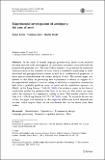| dc.contributor.author | Kotek, Hadas | |
| dc.contributor.author | Sudo, Yasutada | |
| dc.contributor.author | Hackl, Martin | |
| dc.date.accessioned | 2017-01-12T17:46:55Z | |
| dc.date.available | 2017-01-12T17:46:55Z | |
| dc.date.issued | 2015-04 | |
| dc.identifier.issn | 0925-854X | |
| dc.identifier.issn | 1572-865X | |
| dc.identifier.uri | http://hdl.handle.net/1721.1/106359 | |
| dc.description.abstract | In the study of natural language quantification, much recent attention has been devoted to the investigation of verification procedures associated with the proportional quantifier most. The aim of these studies is to go beyond the traditional characterization of the semantics of most, which is confined to explicating its truth-functional and presuppositional content as well as its combinatorial properties, as these aspects underdetermine the correct analysis of most. The present paper contributes to this effort by presenting new experimental evidence in support of a decompositional analysis of most according to which it is a superlative construction built from a gradable predicate many or much and the superlative operator -est (Hackl, in Nat Lang Semant 17:63–98, 2009). Our evidence comes in the form of verification profiles for sentences like Most of the dots are blue which, we argue, reflect the existence of a superlative reading of most. This notably contrasts with Lidz et al.’s (Nat Lang Semant 19:227–256, 2011) results. To reconcile the two sets of data, we argue, it is necessary to take important differences in task demands into account, which impose limits on the conclusions that can be drawn from these studies. | en_US |
| dc.publisher | Springer Netherlands | en_US |
| dc.relation.isversionof | http://dx.doi.org/10.1007/s11050-015-9113-0 | en_US |
| dc.rights | Creative Commons Attribution-Noncommercial-Share Alike | en_US |
| dc.rights.uri | http://creativecommons.org/licenses/by-nc-sa/4.0/ | en_US |
| dc.source | Springer Netherlands | en_US |
| dc.title | Experimental investigations of ambiguity: the case of most | en_US |
| dc.type | Article | en_US |
| dc.identifier.citation | Kotek, Hadas, Yasutada Sudo, and Martin Hackl. “Experimental Investigations of Ambiguity: The Case of Most.” Natural Language Semantics 23, no. 2 (April 25, 2015): 119–156. | en_US |
| dc.contributor.department | Massachusetts Institute of Technology. Department of Linguistics and Philosophy | en_US |
| dc.contributor.mitauthor | Hackl, Martin | |
| dc.relation.journal | Natural Language Semantics | en_US |
| dc.eprint.version | Author's final manuscript | en_US |
| dc.type.uri | http://purl.org/eprint/type/JournalArticle | en_US |
| eprint.status | http://purl.org/eprint/status/PeerReviewed | en_US |
| dc.date.updated | 2016-08-18T15:19:40Z | |
| dc.language.rfc3066 | en | |
| dc.rights.holder | Springer Science+Business Media Dordrecht | |
| dspace.orderedauthors | Kotek, Hadas; Sudo, Yasutada; Hackl, Martin | en_US |
| dspace.embargo.terms | N | en |
| dc.identifier.orcid | https://orcid.org/0000-0001-6855-0314 | |
| mit.license | OPEN_ACCESS_POLICY | en_US |
